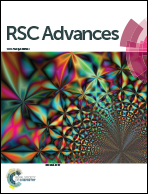Ultrasound-assisted regio- and stereoselective synthesis of bis-[1′,4′-diaryl-1-oxo-spiro-benzosuberane-2,5′-pyrazoline] derivatives via 1,3-dipolar cycloaddition†
Abstract
The 1,3-dipolar cycloaddition reaction of the bis-hydrazonoyl chlorides with 2-arylidene-1-benzosuberone derivatives afforded the corresponding bis-[1′,4′-diaryl-1-oxo-spiro-benzosuberane-2,5′-pyrazoline] derivatives. The reaction is carried out under ultrasonic irradiation as well as under conventional heating. The factors affecting the optimization of the cycloaddition reaction are examined in detail. X-ray crystallographic analysis was used in the establishment of the regio- and stereochemistry of the cycloaddition products.
![Graphical abstract: Ultrasound-assisted regio- and stereoselective synthesis of bis-[1′,4′-diaryl-1-oxo-spiro-benzosuberane-2,5′-pyrazoline] derivatives via 1,3-dipolar cycloaddition](/en/Image/Get?imageInfo.ImageType=GA&imageInfo.ImageIdentifier.ManuscriptID=C5RA02972D&imageInfo.ImageIdentifier.Year=2015)

 Please wait while we load your content...
Please wait while we load your content...